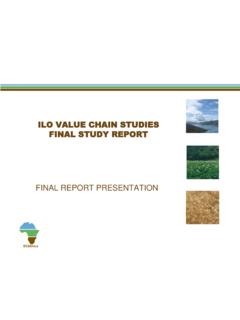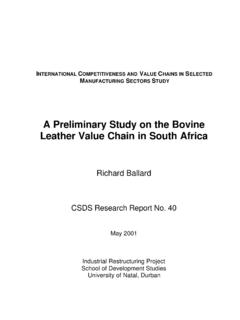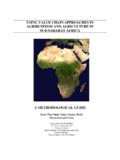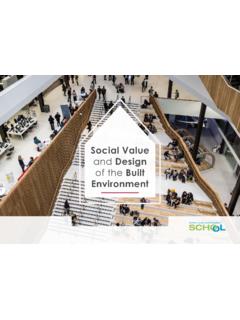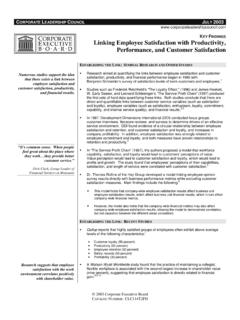Transcription of Developing gender-sensitive value chains
1 Developing gender - sensitive value chainsA guiding frameworkFood and agriculture organization oF the united nations (Fao)Rome, 2016 Developing gender - sensitive value chainsA guiding frameworkThe designations employed and the presentation of material in this informationproduct do not imply the expression of any opinion whatsoever on the part of theFood and Agriculture Organization of the United Nations (FAO) concerning the legalor development status of any country, territory, city or area or of its authorities, orconcerning the delimitation of its frontiers or boundaries. The mention of specificcompanies or products of manufacturers, whether or not these have been patented,does not imply that these have been endorsed or recommended by FAO in preferenceto others of a similar nature that are not views expressed in this information product are those of the author(s) and do notnecessarily reflect the views or policies of 978-92-5-109546-1 FAO, 2016 FAO encourages the use, reproduction and dissemination of material in this informationproduct.
2 Except where otherwise indicated, material may be copied, downloaded andprinted for private study, research and teaching purposes, or for use in non-commercialproducts or services, provided that appropriate acknowledgement of FAO as the sourceand copyright holder is given and that FAO s endorsement of users views, products orservices is not implied in any requests for translation and adaptation rights, and for resale and other commercialuse rights should be made via or addressed information products are available on the FAO website ( )and can be purchased through citationFao. 2016. Developing gender - sensitive value chains A guiding framework. Romecover photos (from top)Women with fruits. San Pedro II, Guatemala. FAO photoWomen collecting clams in the sea shallows, Skhira, Port Zabbusa, Gulf of Gabes. FAO/Giulio NapolitanoPimon (22) is preparing their vegetables fields. Luang Prabang, Laos. IFAD/GMB AkashA woman loads potatoes into sacks at the potato trading market in Dongxiang County, China.
3 IFAD/Qilai ShenMembers of the Musalia dairy group collect milk from farmers in Kitali, Rift valley, Kenya. IFAD/Susan BeccioiiicontentsAcknowledgements vAbstract viList of acronyms viiChapter 1introduction: gender , value chains and sustainability 1 Sustainability: the case for integrating gender into value chain development 3 What to expect from this document 4 Chapter 2 Fao work on gender and value chains 7 FAO institutional context 8 The FAO comparative advantage in relation to gender sensitive value chain development 8 gender sensitive value chain development within FAO 9 Strengthening FAO delivery on gender sensitive value chain (GSVC) development 10 Chapter 3 Key concepts for gender - sensitive value chain development 13 Sustainable food value chain development concepts 14 gender equality and women s economic empowerment concepts 16 Chapter 4 Fao gender - sensitive value chain framework 23A deeper level of analysis: the individual and the household at the core of the framework 24 gender based constraints.
4 An underlying cause of value chain inefficiency 25A first step towards implementing the GSVC framework: gender sensitive value chain analysis 27ivreferences 31 Annex 1 Fao publications on gender , value chains and agricultural development 36 Annex 2 Power and agency indicators 38 FiguresFigure 1: The Sustainable Food value chain Framework 15 Figure 2: Components of access to productive resources 17 Figure 3: Components of power and agency 21 Figure 4: The FAO gender sensitive value chain Conceptual Framework 22 BoxesBox 1: gender and women targeted programmes 14 Box 2: Phases of the SFVC development cycle 15 Box 3: Understanding gender and women s empowerment 17 Box 4: Individual and household levels defined 23 Box 5: A gender sensitive analysis of the cassava value chain in C te d Ivoire 25vacknowledgements The conceptualization of this framework is the result of the fruitful collaboration between Angelica Senders and Anna Lentink (Fair and Sustainable Rural Advisory Services), and Alejandra Safa, Valentina Franchi, Sofie Lambert and Regina Laub (Social Policies and Rural Institutions [ESP], FAO).
5 The publication benefitted enormously from the contribution of Sofie Isenberg (ESP, FAO), who led the writing and editing process of the whole product. Thanks need to be extended to Andrea W hr for the layout and design of the purpose of this publication (part of the FAO series on sustainable food value chain development) is to facilitate the systematic integration of gender equality dimensions into value chain development programmes and projects. It raises aware-ness on gender inequalities and discusses the importance of addressing these dimen-sions in value chain development, while also building a common approach for work on gender - sensitive value chain development. It achieves this by bringing together key concepts from value chain development and gender and by providing concrete guiding principles for the integration of gender concerns into value chain develop-ment projects and programmes. This conceptual framework has a companion publication, Developing gender - sensitive value chains : Guidelines for practitioners, which provides specific tools to support practitioners in designing, implementing and monitoring gender - sensitive value chain of acronymsCEDAW Convention on the Elimination of All Forms of Discrimination against Women FAO Food and Agriculture Organization of the United NationsFMM Multipartner Programme Support Mechanism GBCs gender -based constraints GSVC gender - sensitive value chain SFVC sustainable food value chain SFVCD sustainable food value chain developmentUDHR Universal Declaration of Human Rights VC value chainWEE women s economic empowerment CHAPTER1 Introduction.
6 gender , value chains and sustainabilityIn recent years, trade liberalization, globalization, technological advancement and other major trends have brought important changes to agricultural and food systems. These changes have yielded positive results, such as opening up new markets and creating successful linkages between producers and markets. However, they have also created new challenges for rural actors in gaining access to and benefitting from local, national and global markets (FAO, 2013c). Women in particular experience more difficulties compared to men in accessing productive resources, and in participating in and benefitting equally from agri-food value chains . Women make up 43 percent of the agricultural labour force and are profoundly involved in the production of food and cash crops world-wide, as well as in fishery, forestry and livestock. This gender gap represents a missed opportunity to secure sustainable development for the agricultural sector as well as improved food security and nutrition for all (FAO, 2011).
7 It is the role of the Food and Agriculture Organization of the United Nations (FAO) to make sure that current processes of growth and commercialization in the agricultural sector do not lead to further disempowerment of women and girls, and contribute instead to the sustainable development of agrifood systems. The inclusiveness of agricultural food systems depends on the extent to which they allow the most vulnerable groups (such as smallholders, small enterprises, and women- and youth-run enterprises) to have access to the resources and services they need, and to participate in and earn a living wage1 from their activities. Working towards inclusiveness, social justice and gender equality in agrifood systems entails addressing all levels of the value chain , from the individual producer to the end market, and coming to a comprehen-sive understanding of the issues and constraints that lead to the exclusion and marginalization of stakeholders along the chain .
8 Over the last decade, the value chain (VC) has established itself as one of the main paradigms in development thinking and practice and is now recognized as a key concept in the development of sustainable food systems. Given the large amount of heterogeneous practices and publications that accompanied the rise of the VC paradigm, FAO responded to the growing need for a uni-fied conceptual framework and practical guidance grounded in science by inaugurating a series of handbooks in 2014 on sustainable food value chain development (SFVCD) (FAO, 2014a). 1 Oxfam defines a living wage as one which for a full-time working week (without overtime) would be enough to meet a family s basic needs and allowing a small amount for discretionary spending (Oxfam, 2006).The purpose of this framework and its companion publication, Developing gender - sensitive value chains : Guidelines for practitioners, is to contribute to this series of handbooks in order to ensure that gender equality dimensions are more systematically integrated into programmes and projects, so that women and men can benefit more equally from VC development interven-tions and subsequent improvements in VC IntroductionIntroduction2 Developing gender sensitive value CHAINSC hapter 1312An ResustainaBility: the case For integrating gender into value chain develoPMentGender equality and the development of sustainable value chains are interdependent goals.
9 Major comparative studies have already established that improvements in gender equality and economic growth can be mutually reinforcing, while gender inequalities tend to be costly and inefficient (World Bank, 2001; World Bank, IFAD and FAO, 2009). Closing the gender gap in agriculture can result in major production gains: the FAO report on The State of Food and Agriculture 2010-2011 determined that women s yields could grow by 20 30 percent if the gender gap in accessing agricultural inputs were closed, an increase that could raise total agricultural output in develop-ing countries by 4 percent, which could in turn reduce the number of food insecure people in the world by 12 17 percent (FAO, 2011). Within this context, integrating gender considerations into the development of agrifood value chains is not only necessary from a human rights perspective; it is also a prerequisite to ensuring sustainable growth in areas of intervention.
10 According to UNDP Human Development Report 2011, [i]nequitable devel-opment can never be sustainable human development . The report makes the point that thinking about promoting sustainability as separate from addressing social inequalities in policy-making is not only counter to the basic principles of development, it is also a fundamentally flawed practice (UNDP, 2011). gender dynamics are inextricably bound up with the value chain development cycle: value chain efficiency is highly dependent on strong linkages and posi-tive collaboration among actors, and women are important stakeholders all along value chains , though they are often invisible or relations are a primary component of the social and economic context that shapes VC functioning at all levels, determining factors ranging from the types of jobs that are available to men and women, to differences in remuneration and the qualitative nature of individuals productive roles in the VC ( time use, adoption of labour-saving technologies, and participation in decision-making).










